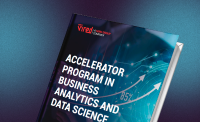The job market has embarked on an extremely competitive path. With more companies opting for skill based talent rather than theoretically equipped, the emphasis placed on upskilling adds tremendous value to one’s profile. That is why, Hero Vired provides you with best in market upskilling classes that are guaranteed to boost your career.
Let’s dive into the nuances of data analytics vs data science, certifications that seems to be booming. Let us help you learn what is data science and what is data analytics, along with difference between data science and data analytics.
What is data science?
The study of data in order to extract meaningful insights for businesses is known as data science. It is a multi-disciplinary approach that employs various concepts from a wide range of disciplines such as artificial intelligence (AI), mathematics and statistics along with computer engineering, in order to analyse large amount of data.
Naturally, you may wonder what data science is used for. After churning data with the help of concepts from above mentioned domains, scientists can use this wisdom to gain knowledge about actions and processes, write algorithms that reuse large quantities of information efficiently, increase security and sequestration of sensitive data, and lead to better data driven decision making.

Get curriculum highlights, career paths, industry insights and accelerate your data science journey.
Download brochure
What is data analytics?
Data analytics is the wisdom of assaying raw data to make conclusions about that information. Numerous ways and processes of data analytics have been automated into mechanical processes and algorithms that work over raw data for human consumption.
Businesses can optimise their performance with the help of data analytics. Enforcing it into the business model can help reduce costs effective ways of doing business. A company can also use data analytics improve business opinions and help dissect client trends and satisfaction, which can lead to newer and better products and services.
What is the Major Difference Between Data Science and Data Analytics?
Data science and data analytics deal with principles on a wide spectrum.
| Feature |
Data Science |
Data Analytics |
| Coding Language |
Python, C++, Java, Perl |
Python and R Language |
| Programming Skills |
In-depth |
Basic |
| Machine Learning |
Required |
Not Required |
| Scope |
Large |
Small |
| Other Skills |
Data mining activities used |
Hadoop based analysis used |
| Data Type |
Unstructured data |
Structured data |
| Statistical Skills |
Necessary |
Minimal or not necessary |
| Goals |
Deals with innovations |
Uses existing resources |
A simple Data Science Course can help you land your desired job profile.
Data science vs. data analytics: Roles & responsibility
The following are just a few examples of the roles & responsibility data scientists vs Data analyst can fill. They work in multiple industries and are responsible for driving an organization’s strategy and decision-making.
What does a data scientist and data analyst do?
Now that we are clear about what is data science and what is data analytics, here’s what a data scientist and a data analyst does. Choosing the best data science certification program to boost your career is essential.
| Data Scientist |
Data Analyst |
- Researching to create algorithms
- Writing codes
- Analyse data for actionable insights
- Identifying appropriate data sets and variables
|
- Gather, observe and analyse key insights to resolve problems
- Employ software and scripting language for presenting the data.
|
Data science vs. data analytics: education and skills required
A common curriculum for data science and data analytic includes math, statistics, computer modeling, programming, and foundational courses in big data and data science.
The following are some of the skill requirements for a career in data science vs data analytics.
- Top Skills Required for Data Scientist
In order to excel in a data science career, you must have
- Deep understanding and practical implementation ability of processing large data sets, statistics, programming, big data, mathematics, machine and deep learning.
- Strong communication to be able to successfully communicate your findings.
- Top Skills Required for Data Analyst
To get yourself on the fast track of data analyst career, keep these skills at your disposal
The following are some of the skill requirements for a career in data science vs data analytics.
Tools & Technologies Used in Data Science
Tools and technologies employed by data scientists are mainly to facilitate seamless processing of massive chunks of data. A good data scientist must know the right tool. We will now have a quick glance at some of the tools used by data scientists –
- BigML – It is simple to solve and automate Classification, Regression, Time Series Forecasting, Cluster Analysis, Anomaly Detection, Association Discovery, and Topic Modeling issues with the help of BigML, a consumable, programmable, and scalable Machine Learning platform.
- D3.js – A JavaScript library called D3.js is used to build interactive browser visualisations. We are able to control website elements within the framework of a data collection, thanks to the D3.js package. Because it allows you to add interactivity and manage how your data is represented, D3.js can be a useful tool for data exploration. In comparison to other libraries, D3.js is one of the top frameworks. This is due to the fact that it is web-based and has excellent data visualisations.
- MATLAB – MATLAB stands for Matrix Laboratory. It aids in providing a numerical computing environment for processing mathematical statements. This language’s most important characteristic is that it aids users in the implementation of algorithms, matrix functions, and statistical modelling of data.
- ggplot2 – The language of graphics, a cogent framework for describing and creating graphs, is implemented by ggplot2. You can accomplish more with ggplot2 by knowing one system and using it in numerous contexts.
Tools & Technologies Used in Data Analytics
Given the complex nature of data analytics job, one must be well aware of common tools used in the field.

- KNIME – KNIME Analytics Platform is a free software that enables non-programmers to access, combine, analyse, and visualise data. Its low-code, no-code interface offers easy to grasp introduction for new users, and an erudite set of data science skills for seasoned users.
- Power BI – With capabilities like Q&A and exporting, Power BI helps report authors to leverage more tools to enhance their reports for analytical insights in their data. In this section, you will carefully review your data and Power BI reports before performing a more in-depth analysis to extract value.
- SAS – SAS is a programme used to examine statistical data. Software for statistical analytics is referred to as SAS. SAS’s primary functions are data retrieval, reporting, and analysis.
- Jupyter Notebook – A free and open-source web application called Jupyter Notebook offers a collaborative computing environment. It generates documents that compile inputs (code) and outputs into a single file (notebooks).
- QlikView – You can quickly create and distribute interactive guided analytics applications and dashboards with QlikView. The way organisations use data has been transformed by QlikView and the ground-breaking Associative Engine on which it is based, placing BI in the hands of a greater number of people than ever before.

Data Science vs. Data Analytics: Career Perspective & Future Scope
The career pathway for Data Science and Data Analytics is quite similar. Typically, Data scientists are much more technical, requiring a mathematical mindset, on the other hand Data Analysts take on a statistical and analytical approach. However, both required a strong educational foundation in Computer Science, or Software Engineering, or Data Science.
The following are the Career Perspective & Future Scope in data science vs data analytics.
Future Scope of Data Science in India
So far, having a closer understanding of what is data science and what does a data scientist do, we have a fair idea about its scope. In a developing country such as India, the arena for data related operations is massive. Since the demand to harness data is rising rapidly, one can only expect an upwards trend.
Future Scope of Data Analytics in India
India has a promising future for data analytics since there are so many young, skilled people, and new businesses and entrepreneurs coming up every day. Due to the evolving technical landscape and more recent business challenges, companies are currently seeking for strategies to boost revenues while lowering operating expenses. As a result, data analytics’ potential in India is steadily expanding. Due to an increased demand and improved pay, it is currently a desirable employment alternative.
Conclusion: Data Analytics vs Data Science, Which is Better?
FAQs
While data analytics is a better career choice for people who want to start their career in analytics, choosing Data science is a better career choice for those who are interested in creating advanced
machine learning models and algorithms.
For data analyst a bachelor’s degree in maths, statistics, economics, computer science or in a similar field will suffice. And, for
data scientist, a degree in computer studies, economics, finance, business studies, statistics, and mathematics will provide an edge.
The job opportunities are vast with rising demand from the government agencies, finance and technology sector, healthcare and business needs.
The industries with high demand for data science and data analytics are technology, healthcare, finance, government agencies, telecom, auto and retail.
Since the background and skill levels are similar, one can choose any of the two careers they wish for.
With high demand from technology, healthcare, finance, government agencies, telecom, auto and retail sector, data science and data analytics are quickly becoming an aspirant favourite.
In simple words, big data refers to any large and complex collection of data, whereas small data comprises of smaller quantities of data involved.
By providing valuable statistics and insights, data science and data analytics help organisations make informed decisions. They have tremendous positive impact on the organisation.
To explain, data engineers build systems for collecting, validating, and preparing high-quality data, while data scientists and data analysts analyse the data to extract knowledge and insights.










